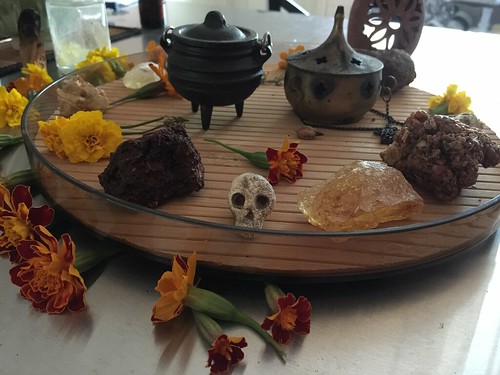Perfumes to Honour the Dead

October 31st marks a special time of the year, from astronomic point of view: Tonight marks the halfway point between the Autumnal Equinox and the Winter Solstice. This is the entrance to the darkest part of the year. It is the night when the barriers between this world and the world of the dead or the spirit world are very thin, allowing passage from one realm to the other.
Even if you don't celebrate Samhain, Hallowe'en or Dia de los Muertos (Day of the Dead) - this night is a befitting time to remember our ancestors, far and near. Light a candle to those we don't remember because they died before we were born, or we were too young when they passed. And for those who were near and dear - this can be done joyfully by preparing their favourite food, or wearing their perfume. Incense and scents in general, for their invisible presence, have historically been the gateway for the underworld, the spirit realm and divinity. Many cultures still use incense in their rituals related to death, funerals and memorials.
The Egyptians were especially elaborate about their preparations for the last journey: They would pack their dead's chambers with all their belongings, including vials of perfumes and cosmetics, and most famously - ensured the body stays as true to form as possible through a meticulous process of mummification, which involved many fragrant aromatics, such as myrrh, pine resin, cedar, cinnamon, juniper and later also frankincense (in the Roman era).
In both China and Japan, incense is burnt daily in domestic altars, to honour the ancestors. In China it is mostly a sandalwood based incense, and in Japan incense sticks of many complex aromatics. In India, incense is burnt on the funeral pyres, to help elevate the spirits of the dead to higher realms, and also to mask the intense smell of burning flesh. Of course, the wealthier the deceased is, the more incense can be burnt. I've even read of using sandalwood as the fuel for pyres of the richest people.
Tobacco is used by the First Nations to communicate with the spirits - almost as a key to their world. It is also believed that offering tobacco will tell other plants that we're seeking their help and guidance. The Cree people would bury their dead holding tobacco and sweetgrass incense, and also personal belonging that would be considered as an extension of themselves, such as their pipe.
The Mexicans use copal incense to show the ancestors' spirits the way back into our world for their annual visit, so that they won't get lost. Marigold flowers adorn the graves and portals through which these spirits are expected to enter. This tradition is rooted in the Aztec customs of giving the Gods offerings of maize (corn), or else - copal moulded to the shape of maize foods, such as grains or ears of corn, and even tamales and tortillas. They also buried the dead with pieces of "jade" - copal resin painted in green, as food for their last journey.
Some of the practices are kept alive today, and others faded away while others disappeared because they seemed to have very little hold in our current reason-obsessed culture. However, one thing is for certain: when you bring forth a scent or an aroma associated with a beloved person who has passed away, you're making that person alive, even if just in your memories.
Tonight I will slice a red grapefruit and uncork a bottle of Old Spice in memory of my grandfather. These fond memories and the love our ancestors poured into us are eternal.

